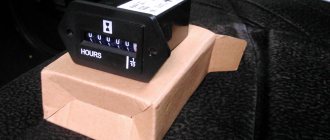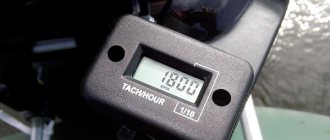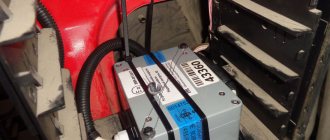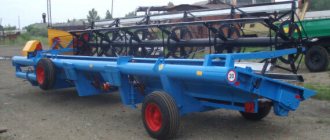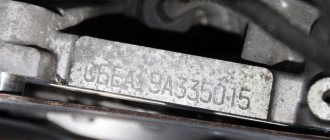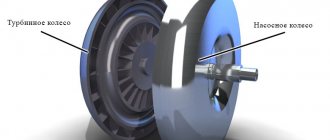Everyone knows how to approximately determine the service life of a passenger car engine - by mileage. Of course, it is important to take into account other factors, such as operating conditions (climate, road quality, load), but in general the condition of the engine is judged by the distance traveled by the car and is rarely mistaken. The more the car has driven, the more the engine has been “overclocked”, the more its components and parts are worn out, and the sooner they will require replacement or preventive maintenance. But how to calculate the engine hours and work volume of tractors, agricultural trucks, and snowplows? Most often, during operation, they travel a very short distance, but they experience a noticeable load. In order to correctly determine the degree of wear, you need to know what engine hours are on a tractor and other equipment and how to count them.
How are engine hours calculated?
The engine hour is a special unit of measurement of the load experienced by a running motor. It corresponds to one astronomical hour of crankshaft operation at idle or moderate speed (60 minutes at about 1500-1600 rpm). This indicator is not equal to mileage or operating time and is relevant primarily for small-capacity vehicles (motorcycles, including cross-country motorcycles), as well as special equipment, the operation of which is not assessed by the distance traveled.
There are different ways to calculate engine hours:
- The most accurate is based on crankshaft revolutions. 1 engine hour is 96,000 crankshaft revolutions (for convenience, you can round up to 100 thousand).
- In terms of time, this is approximately one hour of idling engine operation.
- Based on the fuel used.
Equipment, the amount of work of which is not calculated based on kilometers traveled, is equipped with a special meter that is connected to the spark plugs and reacts to sparks. This is the easiest and most reliable way to count engine hours on tractors, walk-behind tractors and other equipment.
Basic misconceptions and myths
The main misconception among motorcyclists and drivers of agricultural machinery is the equation with a machine hour.
The machine hour is a useful unit of measurement for knowing the exact costs of producing a particular product. Relevant for agricultural machinery, but for bikers it does not provide useful information and is not needed for identification.
Number of comments: 0
Log in to leave a comment SearchLatest articles Is high mileage really that bad for a motorcycle? Motorcycle for travel Rating of motorcycle helmets for 2022 TagsPopular10May New! Thermal underwear Hyperlook Composite July 30 Opening of the Hyperlook brand store February 21 Traditional discounts in honor of Defender of the Fatherland Day
How many engine hours in one hour
It is believed that 1 engine hour can be equated to 1 hour of engine operation at idle speed, but this is a very approximate method. Idle speed varies between vehicles. Only in passenger cars the spread ranges from 500 to 900 rpm, and, for example, in the MTZ-80 tractor they can reach 1500 rpm. The crankshaft revolutions are displayed on the tachometer. The higher the speed, the faster the engine hour is consumed. Therefore, it is impossible to derive a single coefficient to find out how long the engine hour is. It all depends on the working conditions. For example, if a tractor or walk-behind tractor is running on light sandy soil with a cutter or potato planter, the operator will not need to maintain high speeds. And if the same tractor is pulling a truck out of a snowdrift or clearing wet snow, the load on the engine will be higher and the crankshaft will make more revolutions.
What are engine hours on a tractor and other equipment: monitoring service life
Linguists have not come to a consensus on the question of how to correctly write the word “motor hours” - with a hyphen in the middle between the two roots or together. The “Dictionary of Russian Language Abbreviations”, as well as the “Spelling Dictionary” indicate that the word “motor hour” is written together. But writing with a hyphen is not considered an error.
Any mechanism has contacting parts that rub against each other during operation and gradually wear out. The more intense the operating mode, the more significant the wear of the working surfaces. When operating equipment, maintenance personnel are interested in such an important indicator as the remaining service life. The unit of measurement is considered to be “motor hour”. This value characterizes the duration of operation of the mechanism under load.
This is not just the operating time of the mechanism, it is an accounting of the operating time under certain conditions. Astronomical time is adjusted by the value of specific coefficients, which are the result of certain regime measurements. There are devices that remove almost all the necessary information from the mechanism, calculate it and provide the results to the mechanic in real time.
An engine hour is a unit of measurement for the duration of engine operation, taking into account the quantitative characteristics of all factors. For an internal combustion engine, the main measured quantity is the crankshaft revolutions - their number or rotation speed. The engine hour is either less or more than the astronomical hour.
There is no exact definition of the concept of “motor hour”. In practice, it is sometimes replaced by the usual concept of time, which is necessary in economic calculations, for example, to establish maintenance schedules.
How to calculate engine hours
In the practical work of auto mechanics, it is often necessary to count engine hours to draw up operation and maintenance schedules. The problem is not simple. There is no single, universally accepted counting algorithm. Different methods give different results. But as an initial assessment, they are still useful.
Conversion to kilometers
It is also not possible to derive an exact formula for what 1 engine hour is equal to in km. For passenger cars, it can be approximately equated to 12-14 kilometers of quiet driving at moderate speeds or idling the engine. Thus, 15 thousand km is the standard interval for changing oil and some other consumables - this is about 200–250 hours of engine operation.
When driving aggressively, driving on bad roads, transporting cargo or towing, which often requires using full engine power, the engine hours will be “used up” faster. And if the car is driven on busy streets or often idles warm up, these units of measurement become more than mileage. After all, the car is stationary, and the resource of the engine and some other units is consumed. That is why, when replacing consumables, it is better to focus on motorcycle hours rather than mileage.
The issue of accurate calculation is especially important for vehicle drivers working far from qualified assistance (in forest areas, facilities under construction, extreme recreation). They need to know the production so that they can replace or inspect parts in time to avoid unexpected breakdowns. If you can’t rely on mileage, it’s worth purchasing a meter.
In what cases may it be necessary to rewind the engine hours?
The engine operating time meter indicates the degree of engine wear and the need for scheduled maintenance. If such a device does not work correctly, it is impossible to correctly determine the time of decommissioning of the power unit, its output and the remaining reserve. In such cases, the meter must be repaired. If this cannot be done, it is replaced with a new one. And in order not to get confused in the readings, they wind up the engine hours in the required quantity.
Also, services for adjusting engine hours may be needed after a major overhaul of the engine , when its working life is increased due to the installation of new parts and assemblies. Sometimes counters are twisted during pre-sale preparation of equipment.
Regardless of the reasons for the need to adjust engine hours, this work should be performed by experienced craftsmen who are familiar with the structure of meters and the principle of their operation.
Difference between engine hour and machine hour
Machine hours refers to the time it takes one machine to complete a job and also takes into account the number of machines. For example, if one machine clears the street of snow for six hours, it is said that six machine hours were generated. If two machines were assigned to the same amount of work and they cleaned the street in three hours, the work time is multiplied by the number of machines, and the result is again six machine hours. This indicator is important for distributing the load on the vehicle fleet and planning trips. Thus, the exhausted life of the engine is measured in engine hours, and the amount of work of the equipment as a whole is measured in machine hours.
vova1511 › Blog › Kilometers or engine hours?
Engine hours are more indicative than mileage When buying a used car, everyone first looks at the odometer, believing that the condition of the vehicle directly depends on its mileage.
However, mileage does not always indicate how much the vehicle’s resource is actually used up. More precisely, other data allows us to judge the degree of its wear: how many years, months, days, hours and minutes it actually worked. And this depends on many factors, primarily on operating conditions. A FEW years ago, the service mileage for most models according to regulations did not exceed 5,000 km. As technology improves and the service life of lubricants increases, the interval between scheduled maintenance has lengthened first to 10,000, then to 15,000, and for some brands even to 20,000 km. But then the process of increasing mileage between mandatory service visits stopped and even in some cases went in the opposite direction. Dealers began to insist on more frequent vehicle maintenance, citing “particularly difficult operating conditions.” Many clients did not believe them: - Excuse me, what difficult conditions are you talking about? The car does not drive through the Siberian taiga or through the deserts of Central Asia. She practically never leaves the asphalt and never leaves the big city! What's so hard about this? During the service they deceive us, forcing us to undergo maintenance more often than originally prescribed by the manufacturer! In fact, the servicemen are not lying at all. The operating conditions of cars in a modern metropolis are indeed, if not approaching extremes, then at least noticeably different from the calculated ones. This was clearly illustrated by our experiment. We cost more than we drive The editorial test subject was a 2003 Ford Focus. The odometer shows almost 50,000 km. Over the course of a month, we recorded in detail the daily mileage of the car and, more importantly, the travel time with an accuracy of one minute. As soon as the engine started, the stopwatch immediately started. The data obtained was compiled into a table, from which you can find out that, for example, on Thursday, March 29, the car traveled 60.6 km, while it was on the road for 161 minutes. Thus, we obtained detailed information for each day of the experiment. As a result, it turned out that the average daily mileage of the Ford was about 60 km. Knowing the travel time, you can calculate the average speed at which our Ford moved when traveling around Moscow (we never left the city). Only 22.4 km/h. Not much at all, and all because most of the time he was not driving, but standing (of course, with the engine running) in traffic jams, at traffic lights, etc. At best, the car slowly trudged along in first gear in start-stop mode, so that the speedometer needle barely moved near the zero mark. If your car has a trip computer, then you can easily check this data even without the help of a stopwatch. When traveling during rush hour in Moscow, for example, your average speed is unlikely to exceed much more than 20 km/h. Even if on certain sections of the route the flow speed is higher than the 60 km/h allowed in the city, still, when calculating the average value, frequent and long stops will negate this gain.
Total, in conditions without traffic jams, 15,000 km is: - in the city is equivalent
550 engine hours; - equivalent on the highway
Source
What are engine hours
An engine hour is a unit of measurement for the duration of engine operation and its reserve, taking into account all factors, including unstable ones. This parameter cannot be equated to one hour; under certain conditions it is equal to, more or less than a regular hour. When calculating, the operating modes of the unit are taken into account; the crankshaft revolutions are calculated on the tachometer. Since the engine hour does not have an exact concept of time, sometimes it becomes necessary to convert it to the usual astronomical hour, for example, in the case of planning maintenance.
How to write correctly, engine hour or engine hour
If you always write correctly and do not make mistakes in spelling words, you should know that the abbreviation of the concept of “engine hour” is written as “engine hour”, “engine hour” or “motor hour”. Different dictionaries offer different spellings, this is due to the fact that, according to the rule, compound words of all types, to which this term refers, must be written together, but if we consider complex units of measurement, in this case the word already falls under the exception, therefore it is written through hyphen. Linguists have not come to a consensus, and, despite the fact that the continuous spelling is considered outdated, according to the Dictionary of Abbreviations of the Russian Language, as well as the Spelling Dictionary, “motochas” is correct to write. These types of abbreviations are also always written in lowercase letters.
Engine hours on a tractor - what is it, how to calculate it?
Many novice users of heavy agricultural machinery have probably wondered - what are the engine hours on a tractor, how to calculate them correctly and why are they needed at all? Let's consider the most popular questions regarding this unit of measurement of the capabilities of your tractor.
An engine hour is a non-linear unit of measurement of engine operating time. Nonlinear, because one such hour is not equal to one astronomical hour, this characteristic varies. It depends on the number of crankshaft revolutions per hour under different loads. This technological parameter is important in order to control the wear process of the main engine components, ensure their replacement in a timely manner, and simply to be aware of the capabilities of the tractor.
How to calculate engine hours
Many people set the goal of calculations, finding out what the engine hour is equal to in order to calculate how much engine potential is enough. This is not easy to implement, and in any case, the obtained indicators will be relative. Methods for calculating engine hours can be different - from manual calculation with recording of engine performance indicators to the use of mechanical or electrical type meters designed for this, which provides more accurate data, allowing you to monitor the degree of wear. Depending on the accounting method, the parameter may or may not be equal to the standard hour. Engine hours are calculated based on rated power revolutions, that is, an engine hour is equal to an hour of operation at rated speed. At idle, wear is less and the engine hour is higher. Under severe operating conditions, the opposite is true, wear increases (for this reason, if you need to change oils and other consumables, you should not wait for the period recommended by the manufacturer). So, in order to more accurately calculate what one hour of engine operation is equal to, at lower speeds the parameter is calculated by a downward coefficient. Adjustments can also be made to the calculations according to hourly fuel consumption, but clear values cannot be derived.
Adjusting engine hours
The engine hour is the time - one hour during which the engine has been running. But it's not that simple! The engine hour is still not entirely linear time. This is one hour of operation of the crankshaft (its revolutions are counted on the tachometer) of the engine at certain speeds. Accurate information about the number of engine hours traveled is available in the control units (on-board computers) of some car models, and you can find out what the number of engine hours is and most accurately correlate their number with the car’s mileage by reading this information from the car’s computer processor.
Correction of engine hours on trucks is carried out if: • a new engine has been installed. • the dashboard was replaced with a used one.
• non-standard size wheels were installed on the vehicle.
How to find out what ratio of engine hours and mileage corresponds to normal operation of the car?
You need to multiply the engine hours by 50 km. and you will get an approximate mileage (it is considered normal if your mileage is equal to or ± 10-15%), for example:
- In Image 1, the engine hours show 19,994, multiply them by 50 km. and we get a mileage of 999,700 km, multiply it by 0.85 and get a minimum mileage of 849,745 km, if we multiply by 1.15, we get a maximum of 1,149,655 km. The dashboard in Image 1 shows 989,500km. – mileage and engine hours have not been accumulated.
Image 1
- In Image 2, the dashboard shows 20,878 and mileage 571,389km. We apply the formula: 20878 x 50km. x 0.85=887,315 km. – this is the minimum mileage and 20878 x 50 km. x 1.15=1,200,485 km. - this is the maximum mileage. Image 2 shows the mileage.
Image 2
- In Image 3, the dashboard shows 4,446 hours and 597,429 km. We apply the formula 4446 x 50km. x 0.85 = 188,955 km - minimum mileage and 4446 x 50 km. x 1.15 = 255,645 km. – maximum mileage. In Image 3 the engine watch is wound.
Image 3
Makes and models of vehicles we work with:
Mercedes-Benz 4×2 1320; Mercedes-Benz 4×2 1748 LS; Mercedes-Benz 4x2 1836; Mercedes-Benz 4×2 1838LS; Mercedes-Benz 4×2 1840LS; Mercedes-Benz 4×2 1844; Mercedes-Benz 4×2 1846; Mercedes-Benz 4x2 1850; Mercedes-Benz 4×2 1853; Mercedes-Benz 4×2 1853LS; Mercedes-Benz 4×2 1854; Mercedes-Benz 4×2 1935LS; Mercedes-Benz 4x2 1940LS; Mercedes-Benz 4×2 1944LS; Mercedes-Benz 4×2 2036; Mercedes-Benz 4×2 934.032.12; Mercedes-Benz 4×2 944.032.12; Mercedes-Benz 4x2 OM457LA; Mercedes-Benz 4x2 OM501LA; Mercedes-Benz 4×4 2040AS; Mercedes-Benz 4×4 2043AS; Mercedes-Benz 6x2 2541; Mercedes-Benz 6x2 2544; Mercedes-Benz 6×2 2553LS; Mercedes-Benz 6x4 2643; Mercedes-Benz 6x4 2648; Mercedes-Benz 6×4 2653LS; Mercedes-Benz 6×6 3340AS; Mercedes-Benz 6×6 3348 AK; Mercedes-Benz Actros 2041; Mercedes-Benz Actros 3235K; Mercedes-Benz Actros 3236; Mercedes-Benz Actros 1843LS; Mercedes-Benz Actros 1844LNRA; Mercedes-Benz Actros 2540L/NR; Mercedes-Benz Actros 3538; Mercedes-Benz Actros 4140S; Mercedes-Benz Atego 815; Mercedes-Benz Axor 1843LS; Mercedes-Benz LK 1320; Mercedes-Benz LC 1320L; Mercedes-Benz Unimog OM904LA; Mercedes-Benz Vario 612D; Mercedes-Benz Vario 614D; Mercedes-Benz Vario 615D; Mercedes-Benz Vario 618D; Mercedes-Benz Vario 812D; Mercedes-Benz Vario 814D; Mercedes-Benz Vario 814DA; Mercedes-Benz Vario 815D; Mercedes-Benz Vario 815DA; Mercedes-Benz Viano; Mercedes-Benz Vito; Mercedes-Benz 4x2 1117; Mercedes-Benz 4x2 1422; Mercedes-Benz 4×2 1424; Mercedes-Benz 4x2 1528; Mercedes-Benz 4×2 1217; Mercedes-Benz 4×2 1520; Mercedes-Benz 4×2 1831; Mercedes-Benz 4×2 1931L; Mercedes-Benz 4×4 1017A; Mercedes-Benz 6×2 2433; Mercedes-Benz 6×2 2535L; Mercedes-Benz 6x2 2429; Mercedes-Benz G; Mercedes-Benz N; Mercedes-Benz OM457hLA; Mercedes-Benz OM906hLA; Mercedes-Benz OM926LA; Mercedes-Benz O530; Mercedes-Benz OM457hLA (299Hp); Mercedes-Benz 6x4 2635K; Mercedes-Benz 6×6 2629AK; Mercedes-Benz 6×6 2631AK; Mercedes-Benz 8×4 3240; Mercedes-Benz 8×4 3243; Mercedes-Benz 8×4 3343; Mercedes-Benz 8×4 4143; Mercedes-Benz 815; Mercedes-Benz 15RHD; Mercedes-Benz 17RHD; Mercedes-Benz O303PADANE; Mercedes-Benz O303-15R RHS; Mercedes-Benz OM457 hLA (354Hp); Mercedes-Benz OM457 hLA (422Hp); Mercedes-Benz OM457 LA; MAZ 3544019; MAZ 631019; MAZ 631219-420; MAZ 103; MAZ 206; MAZ 544019-421-031; MAZ 544019-1421-031; MAZ 643019-420-010; MAZ 103462; MAZ 103465; MAZ 107466; MAZ 107468; MAZ 203065; MAZ 203067; MAZ 203167; MAZ 152062; MAZ 152A62; MAZ 103562; MAZ 103565; MAZ 206060; MAZ 206067; MAZ 226060; MAZ 226067; MAZ 544018-1320-031; MAZ 544019-1421-031
+7-911-194-00-40
+7-911-001-10-94
Mon.-Fri. from 11.00 to 20.00
SB. from 15.00 to 18.00
How many engine hours in one hour
To find out the degree of wear of engine components, you need to calculate the engine hours. Conversion to real time is required for various reasons, for example, when preparing reports, so many people are concerned about the question of how to convert engine hour to hour. As mentioned above, the engine hour can be either equal to or different from the standard hour. The difference is observed under different operating modes of the power unit, that is, when the loads are too increased or minimal, there will inevitably be discrepancies in the units of measurement. Using the following algorithm, it is easy to calculate the average relative to standard time:
- Engine idle speed equates the engine hour to one astronomical hour;
- During moderate operation, the number of shaft rotations increases by approximately a third, respectively, the discrepancy in units of measurement will be the same third of an hour, that is, under such conditions, 1 Mhr will be equal to approximately 40 real minutes;
- Increased loads lead to accelerated wear of the motor by about two-thirds, then 1 MPH will be about 20 minutes.
The calculated minutes in one engine hour are not an exact value; such an algorithm only allows approximately calculating the wear of the unit, taking into account the intensity of the load. A difference from the real hour will always occur with unstable factors. Do not forget also that the calculation results will be different for a diesel engine and a gasoline engine, since the first one is more powerful (which is why it is more often used in agricultural machinery) and performs tasks in a shorter time interval.
Design and principle of operation of instruments for measuring engine hours
Understanding the importance and necessity of monitoring and accounting for the resource consumption of the unit, engineers developed and put into operation automatic devices - engine hour meters.
Features of hour meters and methods of their use
Different types of meters have been developed for different vehicles.
Hour meter for tractor
The calculation algorithm assumes that at idle, 1 engine hour of the tractor is equal to 1 hour of real time.
At standard load, the engine hour increases by almost a third. Under normal loads, 1 engine hour lasts approximately 40 minutes. Under intense load, the engine wears out two-thirds faster.
Hour meter for tractor PHOTO: drive2.ru
Hour meter for car
Different components of a car wear out differently during the same operating time. It is also important to consider whether the car was in motion or stood still with the engine running. These considerations apply to any vehicle. Typically, 200-250 engine hours for a car is 15,000 - 17,000 km. It all depends on how long the car has been parked with the engine running.
The presence of an hour meter in the car allows the owner to more competently plan maintenance and replacement of components and assemblies.
Different types of sensors have been developed for cars, depending on what unit they are supposed to monitor. All types are based on a time counter, but the difference between them lies in the method of activating the start of the countdown. They can start when the ignition is turned on, when the engine vibrates, or in other ways. The clock mechanism itself can be electromechanical or electronic.
Hour meters vary in price - from quite cheap (no more than 500 rubles), to expensive ones, designed for boats and yachts, in a sealed design, costing up to 8,000 rubles. There are also meters with mechanical drums, like in the odometers of old cars, only they count not kilometers, but engine hours.
Built-in universal tachometer RL-HM005L with hour meter and backlight (backlight only works from an external power supply of 6-48 V). Designed to measure engine speed and operating time. Can be used on motorcycles, snowmobiles, ATVs and outboard motors:
- two-stroke: 1, 2, 3 cylinders;
- four-stroke: 1, 2, 4, 6 cylinders.
For use with gasoline internal combustion engines only. Connects to the engine spark plug, the signal wire is wound around the spark plug
Hour meter for a car PHOTO: alligator-boat.ru
Hour meter for outboard motor
The peculiarity of this counter is that after the first turn on, the tachometer remains on all the time and displays the number of engine hours worked on the screen. You can forcefully turn off the tachometer by pressing and holding two special buttons, but then the engine hour meter will be reset. Switching between modes (tachometer or counter) occurs automatically: when the engine is running, the tachometer is displayed, after the engine is stopped, the hour meter is displayed.
Hour meter for outboard motor PHOTO: mysku.ru
Hour meter for diesel engine
One of the meter options for diesel is model TS-013. This is a non-contact digital tachometer with built-in hour meter function for diesel engines and electric vehicles.
Electronic hour meter for diesel engines PHOTO: mytahometr.ru
Engine hour meter for generator
Maintenance of units, including gas generators, is tied to engine hours or time intervals. The concept of engine hours is discussed above. In the case of a generator, a specific issue is signal pickup and protection from interference. There are capacitive sensors, their connection is non-contact. It is produced by wrapping several turns of the wire coming from the sensor, the high-voltage conductor of the spark plug. The second issue is solved by protecting the device with a tin screen.
Engine hour sensor for a gas generator PHOTO: radiobezdna.ru
Hour meter for walk-behind tractor
Portable non-contact digital inductive tachometer TS-011. Built-in functions of an hour meter and countdown until the next maintenance.
Hour meter for walk-behind tractor PHOTO: promotoblok.ru
Other varieties
Counters activated by pulses from the ignition system.
A counter activated by pulses from the ignition system PHOTO: drive2.ru
Counters activated by engine vibration.
Counter activated by engine vibration PHOTO: drive2.ru
Electromechanical meter with activation when power is applied.
Meter with activation when power is applied PHOTO: drive2.ru
How to convert engine hours to kilometers
It is more correct to calculate the engine life in engine hours than in kilometers, but it just so happens that the mileage is indicated after which an oil change is recommended and other maintenance work on the unit is carried out. This leads to the next question, how many kilometers is 1 engine hour? Since the unit of measurement Mch is relative, it will not be possible to accurately calculate the number of hours worked by the motor based on the number of kilometers “behind your shoulders”; accordingly, the results will be relative. To perform such calculations, the speed of movement and the degree of load on the power unit are taken into account. According to the Order of the State Customs Committee of the Russian Federation dated October 2, 1996. No. 609 “On the introduction of annual standards for the consumption of motor resources (mileage) of motor vehicles”, the average indicator of one hour of operation of a machine driven by a motor not equipped with an hour meter will be equal to the following mileage:
- Cars – 25 km;
- Wheeled tractors – 10 km;
- Crawler tractors – 5 km.
How to wind engine hours
To use, you need to call our managers by phone and agree on a time and place of work. The technician goes to the address specified by the client and, after inspecting the car, does all the necessary work . A special scanner connects to the device and corrects its performance. Depending on the type of counter, programmers and correctors of different operating principles can be used.
Currently, we have the opportunity to work with all types and models of special equipment. If necessary, our craftsmen can wind up the engine hours on a loader, construction equipment, and welding diesel generators. People often turn to us to rewind motor watches for Belarus 622 and other agricultural machinery. All work is completed within 1-1.5 hours , with high quality and with a guarantee.
Why customers choose us: Twisting is impossible to determine
We work with all brands of cars
No chance of error
What is the difference between engine hours and machine hours
We have already looked at the engine hours and found out that this unit is conventional and determines the operating time of the engine during which the crankshaft has completed a certain number of revolutions depending on the degree of load. A machine hour is a unit of equipment working time used in calculating the costs of producing a certain product. This is a completely different concept and converting engine hours into machine hours and vice versa will not work.
Using this parameter and special formulas, the performance of equipment is calculated and the effectiveness of its use is determined. For example, the concept of machine hours is often found in road transport (to establish a process, calculate salaries for employees) or in agriculture (then calculations indicate the time spent on work performed on tillage, sowing, etc.) Information on the full scope of actions performed is summarized, from preparation until the process is completely completed. Having analyzed the situation, we can talk about the payback period of investments, the efficiency and feasibility of using this or that equipment, the profitability of production, etc.
for wheeled tractors 1 m/h = 10 km, for tracked special equipment 1 m/h = 5 km, for vehicles 1 m/h = 25 km.
Order of the State Customs Committee of the Russian Federation dated October 2, 1996 No. 609 “On the introduction of annual standards for the consumption of motor resources (mileage) of motor vehicles”
If the power unit shaft rotates at a variable frequency, then it is much more difficult to accurately calculate engine hours to measure its wear. These power plants are usually used in modern ships. The faster the engine shaft speeds, the correspondingly higher its fuel consumption and the higher the friction in the rubbing pairs and components. In this case, special tachometer metering systems are used to measure engine hours.
In order to accurately count the engine shaft revolutions, a special device is installed on it. All further work is carried out in accordance with the data received from this device. Such a fixation system does not allow you to accurately convert engine hours into real time, since the operating mode of the engine is constantly changing. Therefore, the calculation is made taking into account the average speed, and is called the empirical conversion factor.
Materials from the site www.gps-spb.ru. When copying text, an active link is required.
Free hotline Rumix
Demo login to the monitoring server
Free server program
We work with all regions Taxi monitoring
Taxi car monitoring
Taxi tracking system Voyager 2 Light RUB 7,257 with installation. Integration with the TaxiMaster control system. How to order installation Request a quote
We will make an accurate calculation of the cost of equipment to suit your requirements Buy SIM cards
Buy SIM cards from a mobile operator for installation in devices Access via the Web
After on-site installation you will have access to the web server Integration
Integration of 1C1C ENTERPRISE. Automatic export of reports on routes, speed, mileage, fuel consumption.
Integration with TAXIMASTERTAXIMASTER, you can manage a taxi fleet thanks to the integration of the Voyager Light systems and the TAXIMASTER system
Correct calculation of fuel consumption rate for a forklift
One of the most important questions that any owner of this equipment faces. Sometimes the manufacturer clearly indicates fuel consumption per power unit (horsepower or kilowatts) in grams. You can find this information in the loader specifications table. However, for all its usefulness, it does not give a clear idea of how much fuel is required for operation.
How to determine the consumption rate for 1 engine hour?
It is calculated as follows:
Q = Nq/(1000Rk1), where:
- N is the power of the power unit;
- q is the indicator of specific fuel consumption of the loader;
- R is the density of the fuel (diesel). Usually taken at the level of 0.85 kg/dm3;
- k1 is the percentage ratio of the operating time at maximum crankshaft speed.
The power of the power unit, as well as the specific fuel consumption, can be found in the maintenance instructions. The data is included in it in the form of a graph. It is built by specialists from the manufacturing plant. The basis for this is the results of tests in different modes. In practice, achieving the maximum speed of the power unit is very simple - press the gas pedal all the way.
As a result, the loader accelerates, overcomes the rise with the load, lifts it to the maximum permissible height and all this, mind you, at maximum speed. Of course, in this mode the loader will only work for part of the shift. Therefore, it is necessary to use a coefficient designated as k1: it characterizes operation at maximum speed.
It can be called an individual indicator of the specifics of the loader’s operation.
Calculation example
Let's assume that a diesel forklift was rented to load trucks and unload wagons. It works for the entire shift (8 hours), without overcoming slopes and without using the maximum fork lift height, since the sites it serves are located at a height of only 1,500-2,000 mm. The maximum engine speed is only used when the unit is accelerating to cover the distance between the loading and unloading areas. This operation takes approximately 30% of working time.
But it may be so. The company operates 24 hours a day. But shipment of materials (products) during this time is carried out only 2 times for 2 hours. The remaining time the loader is operated with minimal or medium intensity.
Accordingly, the coefficient characterizing the ratio of operating time with load (maximum/minimum) is lower in the second case. Its value can be accurately determined by measuring the time during which the loader overcomes the resistance of the surface (road) and lifts loads of maximum weight. Summing up the indicators, we obtain the operating time during which maximum loads are applied to the unit. And it is this time that needs to be subtracted from the duration of the (total) one shift.
The required coefficient is the ratio of operating time with minimum and maximum load (70% and 30%, respectively). Therefore, if the forklift was used with a maximum load of 30%, then the value of the coefficient is found by dividing 70% by 30% (that is, the value is 2.3).
For example, the well-known AX50 loader model from Komatsu is equipped with a 4D92E power unit. Its power is 33.8 hp. With. In the event that 30% of the entire work shift is operated at maximum speed, then the fuel consumption for 1 engine hour will be: 33.8x202/(1000x0.85x2.3) = 3.49 liters.
On the practical aspects of fuel consumption rates
Of course, there are certain differences between theoretical calculations and practice. Fuel consumption is affected not only by the duration of operation at maximum speed, but also by the power of the power unit and specific fuel consumption.
Equipment that has not been run-in and loaders with an impressive mileage demonstrate higher fuel consumption than those whose engines have been adjusted. Excessive consumption can also be detected during special testing in the case of operation at maximum load. For example, a one and a half ton car can show consumption from 5 to 6 liters per hour, although the average value of this indicator is 3 liters per hour.
This is interesting: DIY mini tractor from scratch and from a walk-behind tractor
Why do you need to count engine hours?
Having figured out how to calculate the engine hours on a tractor, you can now move on to the question of why these calculations are needed. First of all, the answer to this question lies in the peculiarities of the calculation process itself - it is based on the number of engine revolutions per minute. Considering that each moving mechanical joint has its own safety margin designated by the manufacturer, it is possible to calculate the time for scheduled engine maintenance in advance. At the same time, knowing how the hour meter on a tractor works, it is not difficult to do this accurately, based on the actual wear of the crankshaft, piston system and other components of the power plant.
Knowing the actual operating characteristics of the engine can easily convert engine hours into kilometers on a tractor in each individual case. There is a special average table that suggests that 1 m/h for wheeled tractors is 10 kilometers, for tracked ones - 5 kilometers. But for an accurate calculation, many factors must be taken into account, ranging from driving speed to engine load. In addition, the design of the sensor allows you to wind up the engine hours, turning any calculations into a useless exercise. Although today this is a rather rare occurrence, since the decision to “wind up” the meter belongs more to the “Soviet era”. At that time, the engine hour was one of the indicators of operating time, and today it is a means of saving, monitoring fuel consumption and the performance of the power unit.
You can find out about the mileage of a car engine, ships, agricultural machinery, pump drives, diesel generators or other stationary devices running on motors by assessing the true wear of the unit. When determining the service life, the engine hours are taken into account first, since this parameter affects the performance and recommendations for the operation of a specific vehicle model or device. The measurement is performed in the same way for different units installed on vehicles, as well as those operating stationary. Due to the fact that mileage indicated in kilometers does not reflect the actual wear pattern of engine components, engine hours are used for a more accurate determination.
Information about direct wear and tear is important for monitoring the performance of the engine, accurately determining the timing of maintenance, repairs, replacement of consumables and structural parts, etc. The exhaustion of the service life brings the time of maintenance closer, so information about engine hours allows you to monitor indicators and indicates the need to change consumables. Each engine has different characteristics, so there are no uniform standards for maintenance within a strictly designated period; in the technical documentation for the equipment, the manufacturer specifies replacement periods, but in reality they can vary depending on operating conditions.
How to determine mileage using engine hours
Engine hours are more indicative than mileage When buying a used car, everyone first looks at the odometer, believing that the condition of the vehicle directly depends on its mileage. However, mileage does not always indicate how much the vehicle’s resource is actually used up. More precisely, other data allows us to judge the degree of its wear: how many years, months, days, hours and minutes it actually worked. And this depends on many factors, primarily on operating conditions.
A FEW years ago, the service mileage for most models according to regulations did not exceed 5,000 km. As technology improves and the service life of lubricants increases, the interval between scheduled maintenance has lengthened first to 10,000, then to 15,000, and for some brands even to 20,000 km. But then the process of increasing mileage between mandatory service visits stopped and even in some cases went in the opposite direction. Dealers began to insist on more frequent vehicle maintenance, citing “particularly difficult operating conditions.” Many clients did not believe them: - Excuse me, what difficult conditions are you talking about? The car does not drive through the Siberian taiga or through the deserts of Central Asia. She practically never leaves the asphalt and never leaves the big city! What's so hard about this? During the service they deceive us, forcing us to undergo maintenance more often than originally prescribed by the manufacturer! In fact, the servicemen are not lying at all. The operating conditions of cars in a modern metropolis are indeed, if not approaching extremes, then at least noticeably different from the calculated ones. This was clearly illustrated by our experiment. We cost more than we drive The editorial test subject was a 2003 Ford Focus. The odometer shows almost 50,000 km. Over the course of a month, we recorded in detail the daily mileage of the car and, more importantly, the travel time with an accuracy of one minute. As soon as the engine started, the stopwatch immediately started. The data obtained was compiled into a table, from which you can find out that, for example, on Thursday, March 29, the car traveled 60.6 km, while it was on the road for 161 minutes. Thus, we obtained detailed information for each day of the experiment. As a result, it turned out that the average daily mileage of the Ford was about 60 km. Knowing the travel time, you can calculate the average speed at which our Ford moved when traveling around Moscow (we never left the city). Only 22.4 km/h. Not much at all, and all because most of the time he was not driving, but standing (of course, with the engine running) in traffic jams, at traffic lights, etc. At best, the car slowly trudged along in first gear in start-stop mode, so that the speedometer needle barely moved near the zero mark. If your car has a trip computer, then you can easily check this data even without the help of a stopwatch. When traveling during rush hour in Moscow, for example, your average speed is unlikely to exceed much more than 20 km/h. Even if on certain sections of the route the flow speed is higher than the 60 km/h allowed in the city, still, when calculating the average value, frequent and long stops will negate this gain.
Total, in conditions without traffic jams, 15,000 km is: - in the city is equivalent
550 engine hours; - equivalent on the highway
The total mileage of a car is a very conditional characteristic of its technical condition. Nevertheless, the reliability of the odometer reading has always been the main issue for the buyer of a used car. How can you verify the authenticity of the mileage?
You can estimate mileage in different ways. Among them, unfortunately, there is no universal method: as we will see, each is applicable only in certain conditions, but together they make up a good arsenal for fighting dishonest car sellers.
Autocode
However, even in this form, “Autocode” can be very useful - after all, checking does not require effort, and the developers promise to add new mileage control points over time, in particular when contacting insurance companies.
Service history
Maintenance invoices or a service book are the best proof of the reality of the mileage. Of course, not everyone continues to be serviced by dealers after the warranty expires, but even a few marks in the first years will allow you to assess the intensity of the car’s use. Agree, it’s strange to see a car that, according to the service book, covered 40 thousand km a year, and then, when the service history was interrupted, allegedly sharply reduced the annual mileage of thousands to 5 thousand.
Contrary to skeptics who claim that a service book can be bought and faked on every corner, in practice fakes are extremely rare. After checking the mileage, the incriminating evidence is simply thrown away, and therefore the lack of a service history is always a reason to be wary.
Computer diagnostics
The capabilities of computer diagnostics are often exaggerated, imagining that the car’s electronic memory contains a mandatory “real mileage” parameter that just needs to be counted. In reality, everything is not so straightforward and simple. Using a computer, it is possible to obtain various indirect data: for example, mileage at the time of the occurrence of a particular error, the distance traveled since the moment of any event, the number of starts and operating time of the engine, etc. This is where the discrepancies appear! The odometer shows 70 thousand km, but for some reason the error appeared at the 210th thousand... The seller claims that the car has covered 60 thousand, but dividing the mileage by engine hours, we get an average speed of only 3 km/h... And the more complex the electronics are car, the more such “oddities” appear, the more difficult it is to lose mileage without leaving a trace. If the Mercedes-Benz S-Class even stores information about visiting a service, then the Renault Logan can only determine the mileage since the errors were reset, although this information can be useful.
You can carry out a computer check yourself - in fact, you only need a laptop and an adapter adapter special for the selected car brand. There are also universal scanners on sale, but you need to take into account that simple models are only suitable for reading errors and viewing a standard set of parameters, while professional multi-brand devices that provide the required level of diagnostics are already very expensive.
Vehicle condition
Although imprecise, it is always an accessible method - simply try to compare the mileage and condition of the car: see how much wear the steering wheel and pedal pads have, what condition the seat upholstery is in, how well frequently used buttons are polished, assess the wear of the tires and brake discs. Of course, wear resistance depends significantly on the car model, and, in the absence of experience, it is difficult to interpret what you see, but you can still set some starting points. In particular, with rare exceptions, even the slightest signs of interior wear appear no earlier than the first fifty, and until then the interior of any car remains in new condition. Then, starting from 50 thousand, traces of use are already noticeable in the interiors of Korean cars, especially on the thin leather of the steering wheel and silver-painted parts. Finishing materials made by “Japanese” and “Europeans”, as a rule, successfully last up to 70–100 thousand, and expensive German cars may not show their mileage up to 150 thousand km.
Tires can also serve as a guide. On their side there is a release date - four digits: the first two indicate the week, the second two - the last digits of the year. Having determined in this way whether this is the first set of tires or not, you can estimate the mileage based on the tire service life of approximately 50 thousand km. It’s a good idea to open the hood and look under the oil filler cap: a dark coating on metal parts will indicate either poor quality oil or high mileage.
In conclusion, it should be noted that when selling a car with incorrect mileage, scammers are counting on an unprepared, inattentive buyer. Their actions are simple: change the odometer readings, get rid of the service book, tidy up the interior. They don’t make any special efforts to hide the deception - and they will buy anyway. This means that an inquisitive buyer will always suspect something is wrong; all that is required is attention and a critical approach.
You can find out about the mileage of a car engine, ships, agricultural machinery, pump drives, diesel generators or other stationary devices running on motors by assessing the true wear of the unit. When determining the service life, the engine hours are taken into account first, since this parameter affects the performance and recommendations for the operation of a specific vehicle model or device. The measurement is performed in the same way for different units installed on vehicles, as well as those operating stationary. Due to the fact that mileage indicated in kilometers does not reflect the actual wear pattern of engine components, engine hours are used for a more accurate determination.
Information about direct wear and tear is important for monitoring the performance of the engine, accurately determining the timing of maintenance, repairs, replacement of consumables and structural parts, etc. The exhaustion of the service life brings the time of maintenance closer, so information about engine hours allows you to monitor indicators and indicates the need to change consumables. Each engine has different characteristics, so there are no uniform standards for maintenance within a strictly designated period; in the technical documentation for the equipment, the manufacturer specifies replacement periods, but in reality they can vary depending on operating conditions.
Features of engine hour calculation
What the engine hours on a tractor are is quite simple to imagine if you understand how this parameter is fixed. At the moment the engine starts, a mechanical or electronic counter also turns on, which begins to record and remember the shaft speed using a special indicator. This device for determining the operating hours of tractors allows you to determine the duration of its operation for any period of time. But at the same time, the statement that 1 tractor hour is equal to one hour of real operating time is erroneous.
The calculation is based on the number of revolutions per minute. Consequently, it may differ several times under load and at idle. It turns out that if you count the engine hours, you can find out the approximate degree of wear of the moving mechanical components of the power unit. The formula for calculating them is quite simple and is based on the number of revolutions:
- idling allows you to equate one engine hour to an hour of real time;
- a normal load “speeds up” the engine hour by about a third - 1Mh is approximately 40 minutes;
- intense load leads to “acceleration” of wear by two thirds.
This diagram allows you to roughly clarify what the engine hour on a tractor is, depending on the intensity of its use.

